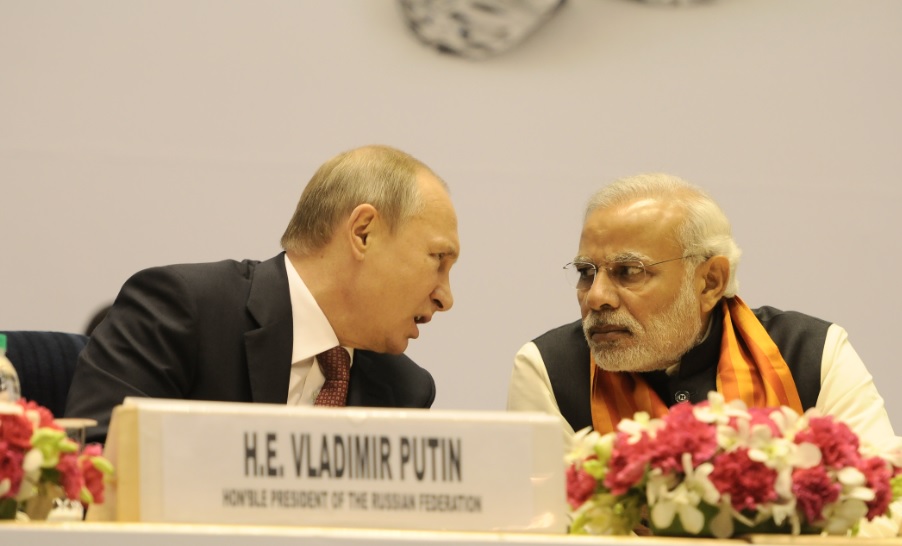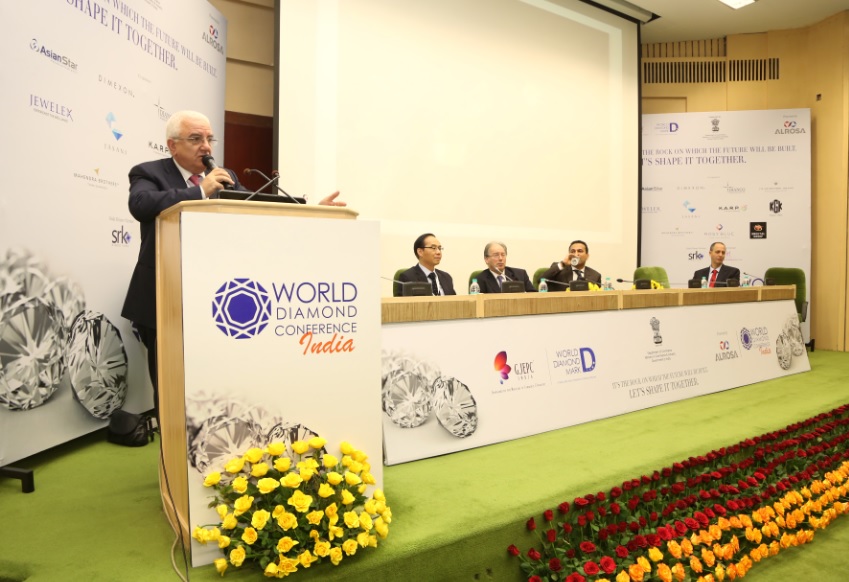The World Diamond Conference that took place last week in New Delhi, India, created a buzz in the industry that, frankly, needed a bit of a pick-up considering the state of the market. It not often that two heads of state attend a diamond sector event and, in doing so, offer such unwavering support for the industry.
Organizers were therefore correct to claim the success that they did as there was a tremendous feel-good factor apparent in seeing India Prime Minister Narendra Modi and Russia President Vladimir Putin inaugurate the event. Consequently, much of the focus of the two-day conference was dedicated to India and Russia burgeoning relationship.

However, beyond the pomp and ceremony, the conference offered another opportunity for the trade to debate its most pressing issues. Perspectives were offered from all segments, including mining companies, manufacturers, retailers and, most importantly, bankers.
After a challenging year in 2014, the conference stressed that the long-term sustainability of the industry can only be ensured if steps are taken to improve the bankability of the trade and to boost consumer demand.
Here are five things that we learned at last week World Diamond Conference in New Delhi:
1. The industry in India has unprecedented access to government.
When Prime Minster Modi was elected to office in May, there was excitement throughout the local diamond trade. As a former State Minister of Gujarati, the industry felt some kinship with Modi as he supported the emergence of Surat as the primary diamond manufacturing center.
Add to that the sense that the gem and jewelry trade had not been a priority of the previous government in recent years as gold and diamond import duties had been raised in an effort to control the current account deficit. Also, economic growth slowed and the rupee slumped in 2013 under the previous government watch paving the way to Modi election amid industry dissatisfaction.
The conference in New Delhi signaled that the diamond trade has the government ear. Not only did Modi inaugurate the conference, but other high-ranking government officials participated, among them the State Minister for Commerce and Industry, the Secretary for Financial Services, the Joint Secretary for the Ministry of Commerce and Industry and the Secretary for the Ministry of Mines.
Modi said that the diamond industry, among other sectors, has huge potential for creating employment and generating exports and that the development of such sectors is a great priority for his government.
It appears that the diamond industry, under the Gem and Jewellery Export Promotion Council (GJEPC), has every opportunity to leverage that support.
2. Russia and India make sensible rough diamond bedfellows.
Modi proposed three industry-related developments in his meeting with Putin.
It was subsequently announced that ALROSA has increased the number of its India-based long-term contract clients from eight to 12 starting in 2015. This move was in the cards for a long time as matching the largest supplier of rough diamonds by volume with the world largest diamond manufacturing center should be a natural development.
Historically, approximately half of ALROSA supply is sent to Belgium with many of its Antwerp-based clients being Indian companies. In fact, while India accounted for 13 percent of the mining company total supply in the first nine months of 2014, an estimated 50 percent of ALROSA rough goes to Indian entities, Vipul Shah, chairman of the GJEPC told the conference.
One might also consider that European Union (EU) sanctions imposed on Russia may influence ALROSA long-term supply agreements that are currently being negotiated. While the sanctions do not include the diamond trade, the Russian government which still has a stake in ALROSA must surely be looking at alternative, more friendly partners with which to do business.
Modi is keen to nurture that partnership. His second appeal to Putin was to abolish Russia import duty on polished diamonds from India in order to reciprocate Russian rough supply with Indian polished.
3. India has rough trading ambitions.
Modi third proposal was for ALROSA to sell its rough directly in the Special Notified Zone (SNZ) being set up in the Bharat Diamond Bourse (BDB). The government approved and announced at the conference the creation of the zone that will enable major mining companies to send rough to India on consignment and re-export unsold goods without being subject to taxes.
The zone was a long time in the making as India aims to compete with Belgium and Dubai in the rough trading space, and consequently attract the many Indian businesses in both those centers back to Mumbai. An area has been set aside in BDB for the zone, which is expected to open in 2015, and the extent to which mining companies use the facility will be a development worth watching next year.
4. Mazal Uracha is simply not good enough for the bankers.
More telling next year will be the extent to which the industry can generate additional bank credit. In fact, if there was one key message to manufacturers at the conference, it was that the industry needs to improve its ankability,or arn the right to exist,from a banker viewpoint.
Erik Jens, CEO of ABN Amro Bank Diamond and Jewelry Group, said quite frankly that the industry hasn sufficiently polished its operations to be attractive to lenders.
If bankability is the sum of profitability and transparency, he explained, then diamond companies need to comply on both accounts. They need to improve their asset controls, present consolidated reporting and show clear corporate governance. Destocking and reducing non-value-added trade will also be essential to prove their profitability to the banks. Transparency will be measured by presenting audited and complete sets of accounts, consolidated reporting, clear corporate governance, independent stock evaluations and compliance of business processes and applications. Banks are also increasingly considering the corporate social responsibility activities of their clients.
Howard Davies, head of corporate development at De Beers, added that the banks have no choice but to insist on these measures given their own compliance requirements outlined by new regulations such as the Basel accords.
As a result, he stressed that the industry needs to shed its traditional reliance on trust, and its ability to close a deal based on a handshake, or Mazal Uracha, if it wishes to attract additional financing. Simply put, the industry pride in such unique trust is working to its detriment.
In that spirit, Davies explained that De Beers is insisting on financial compliance from sightholders as it negotiates new long-term sight contracts that will take effect in 2015. In a sense, the aim is to normalize reporting in the diamond business.
In the modern world, for the diamond industry to retain its right to be funded, it must abide by the same rules as every other business sector,he said. It must be corporate, it must be accountable and it must be transparent. There is no option.

While De Beers has shifted from generic to brand-focused marketing, and considering the amount spent on advertising by the major jewelers, he noted that the diamond industry investment in marketing has actually not decreased. However, it is not investing as much as its competing industries few of which have generic campaigns and is therefore losing market share.
Alex Popov, chairman of the World Diamond Mark Foundation (pictured above), noted that diamonds have fallen behind leather goods, travel and elective health procedures, and will soon be surpassed by electronic goods, in the ranking of the most desired luxury products.
Popov considers the WDM to be the guardian of the idea that the diamond itself is a brand. The mark recent launch in Turkey and Dubai will try to nurture that goal, restore diamonds to the top of the most desired list and hopefully benefit all segments of the pipeline.
Lussier meanwhile stressed that it not enough to grow consumer demand if it doesn create additional margins at the retail end. He added that margins can only be achieved through branding, which also contributes to the overall desire for the product category.
Manufacturers in the room were probably wondering about their own margins. Perhaps their best option is to participate in existing marketing initiatives such as Forevermark and the WDM. Jean-Marc Lieberherr, managing director of Rio Tinto Diamonds, stressed that such collaboration is vital to ensure industry growth.
Working together in the spirit of partnership across the whole value chain from mine to retail is the most powerful way to create sustainable value in the industry,he said.
It is unclear what role the mining sector can play in the WDM short of funding it, which they are unlikely to do. Rather, it is hoped that the initiative will enable manufacturers and dealers a role in telling the diamond story together with their retail partners.
Either way, in these initial stages, the hope is that the WDM will create a buzz in the consumer space as the foundation did in organizing such a landmark conference together with the GJEPC. Mind you, as the discussions in New Delhi reflected the somber mood of the trade during 2014, there a lot of work yet to do. .





